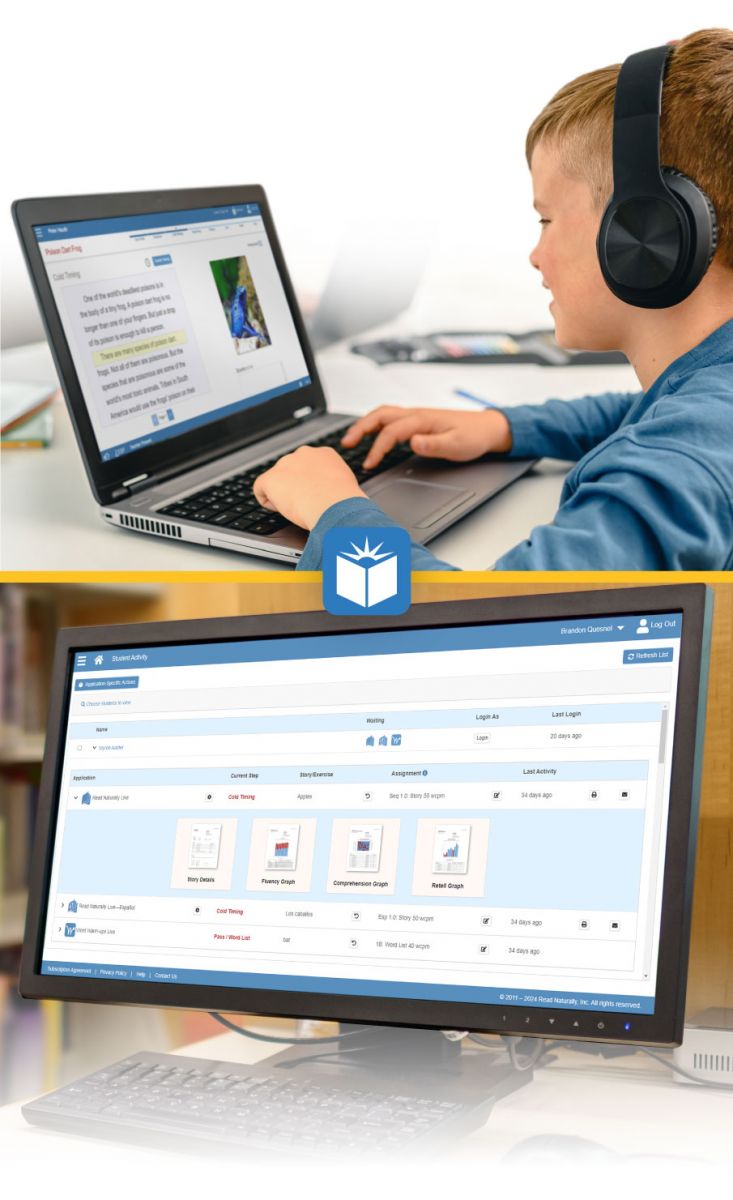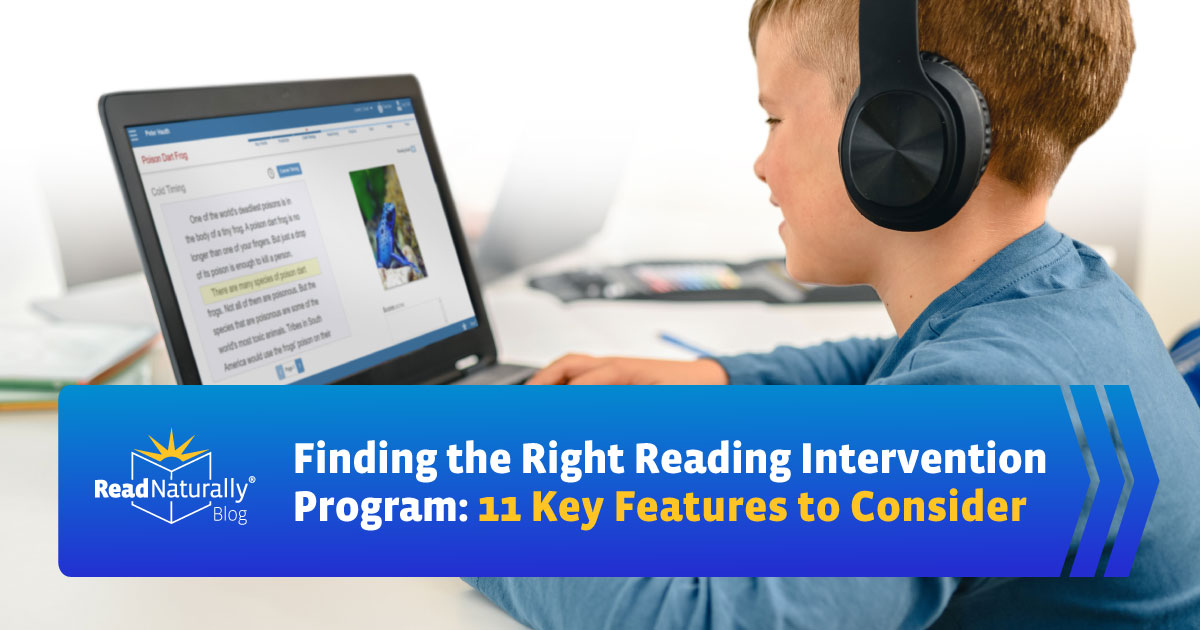When it comes to reading intervention, the importance of a quality program cannot be overstated. With so many options available, it can be challenging to determine which program will best suit the needs of your students. Here are eleven key features to consider when looking for a reading intervention program:
1. Comprehensive Reading Components
A quality reading intervention program should offer instruction and practice in all five essential components of reading: phonemic awareness, phonics, fluency, vocabulary, and comprehension. Students should be able to focus on the component(s) in which they need support. This ensures that students develop all the critical skills necessary for reading success.
2. Alignment with the Science of Reading
A program aligned with the Science of Reading is backed by scientific research on how students best learn to read. It should include evidence-based practices for teaching students essential reading skills, providing effective strategies and activities to promote and measure progress.
3. Customizable to Individual Student Needs
Students need varying levels of support in the different areas of reading, so a reading intervention program must allow for differentiated instruction. The program should be easy to customize so that students can focus on the areas of reading instruction they need most, whether it’s phonemic awareness, phonics, fluency, vocabulary, comprehension, or all of the above. Not only should it be customizable to meet individual student needs, but it should also be easy to adjust over time to meet the changing needs of students as they develop their skills. Teachers should be able to adapt the program as they consider foundational skills, reading levels, goals, reading stamina, age, and support for English learners.
4. Optimized Teacher Involvement
Teacher involvement is essential, and a program must include opportunities for teachers to provide feedback and work directly with students. Teacher time is the most valuable resource, and it is also finite, so a program must make efficient use of it. The program should provide all the necessary tools for students to work independently in an engaging and effective manner. These tools include appropriate content, structured instructional routines, and comprehensive data analysis. Teachers can then focus their valuable time on understanding individual students and providing targeted instruction to address specific needs. This ensures that the teacher's expertise is leveraged where it is most impactful.
5. Progress Monitoring
Effective programs incorporate ongoing use of progress monitoring data and other diagnostic data sources to intensify and individualize the intervention based on student needs. The data should be accessible, detailed, and easily interpreted, empowering teachers to make informed decisions. Reports should be consistent and structured, making them easy to share with students, between the teacher team, and with parents to ensure everyone has the same understanding of the student’s progress. Progress monitoring should also be used to engage students in their learning process, increasing their motivation and reading achievement.
6. Transfer of Skills
The program should help students make connections between the skills taught and those learned in other contexts. Students should have opportunities to apply and synthesize information, ensuring they can transfer their learning to various situations. Repeated reading and teacher modeling are effective ways to solidify the skills so that students are more apt to automatically apply them in other academic areas.
7. Student Accountability
An effective program identifies learning targets for the student and holds them accountable for working toward and developing the targeted skills. The program should require students to demonstrate mastery of the targeted skills.
8. Path for Students to Exit Intervention
The program should have a clear path for students to exit intervention, involving a gradual release of support. This helps students catch up to their peers and confidently read grade-level material as soon as possible.
9. High-Quality, Engaging Texts
High-interest, engaging texts are crucial for maintaining student motivation and investment in learning. The program should incorporate informational texts to build background knowledge and foster comprehension. Texts should be appropriate for various ages and ability levels.
10. Teacher-Friendly Implementation
The program should be easy to understand and implement for both new and experienced teachers. It should ensure consistency in teaching, streamline preparation, and allow flexibility to adapt to different student and classroom needs. Additionally, volunteers and classroom helpers should be able to assist with implementation after minimal training.
11. Professional development/training/support
Ongoing, easily accessible teacher support is vital. Programs that offer built-in professional development help teachers feel more confident and prepared in their instruction. Robust training and support ensure that educators can effectively implement the program with fidelity and maximize its benefits.
Bonus: Affordability
Budgets are always a consideration. The program should be cost-effective, providing high value for the investment. It should be easy to maintain within the budget over time, ensuring that schools can continue to provide essential reading support without financial strain.
 Introducing Read Live
Introducing Read Live
Considering these essential elements, we’re excited to offer Read Live, a reading program that incorporates all of these features. Designed to make reading instruction straightforward and effective, Read Live includes:

- Support, practice, and explicit instruction in the essential components of reading
- Alignment with the Science of Reading
- The evidence-based Read Naturally Strategy, which numerous studies over 30+ years have shown to be highly effective
- Myriad customization options
- Efficient, required opportunities for teacher involvement
- Detailed, easy-to-interpret reports and graphs
- Activities that involve teacher modeling, repeated reading, and comprehension
- Systems to ensure student accountability and mastery of skills
- Strategies that accelerate progress and features to gradually release support
- High-quality, engaging, nonfiction texts
- Ongoing professional development and support for educators
- Affordable pricing plans
Read Live is made up of the following components:
A comprehensive reading program
 Learning to read requires more than isolated skill practice. Read Naturally Live delivers everything students need to become strong, confident readers—phonics, fluency, vocabulary, and comprehension—all in one powerful, easy-to-implement program.
Learning to read requires more than isolated skill practice. Read Naturally Live delivers everything students need to become strong, confident readers—phonics, fluency, vocabulary, and comprehension—all in one powerful, easy-to-implement program.
A phonics reading program
 Many students have phonics gaps, and Word Warm-ups Live helps close them quickly. It delivers explicit, systematic instruction paired with targeted, efficient practice. Streamlined phonics assessments make it easy to identify needs and monitor progress.
Many students have phonics gaps, and Word Warm-ups Live helps close them quickly. It delivers explicit, systematic instruction paired with targeted, efficient practice. Streamlined phonics assessments make it easy to identify needs and monitor progress.
An independent reading program
 Independent reading time can mean wasted time for many students. One Minute Reader Live provides high-interest content and structured support—so students spend more time actually reading, not just pretending to. Teachers see evidence of progress through auto-generated reports.
Independent reading time can mean wasted time for many students. One Minute Reader Live provides high-interest content and structured support—so students spend more time actually reading, not just pretending to. Teachers see evidence of progress through auto-generated reports.
A Spanish-language reading program
 Read Naturally Live—Español helps students in dual- and world-language programs develop reading proficiency in Spanish. It also supports Spanish-speaking English learners in developing home-language literacy—a key foundation for making faster progress in English.
Read Naturally Live—Español helps students in dual- and world-language programs develop reading proficiency in Spanish. It also supports Spanish-speaking English learners in developing home-language literacy—a key foundation for making faster progress in English.
Read Live also has:
Evidence-based studies
Numerous studies document the effectiveness of Read Live and the learning strategy it employs.
Phonics Assessment
Read Live includes a Phonics and Word Analysis Assessment designed for both placement and progress monitoring purposes.
Data Analysis
The AI-driven Data Mentor feature provides continuous data analysis and offers actionable insights focused on maximizing student progress and saving teachers’ time.
Remote Learning features
Read Live is adaptable for various instructional settings, including distance learning.
Age-appropriate UI
Read Live is designed to engage students of all ages, ensuring that it maintains their interest and motivation. The program avoids images, characters, or content that may be off-putting to older students.
Latest (& constantly improving) technology
Read Live incorporates the latest technology, including speech scoring technology, to streamline the fluency placement process and get students reading right away.
Live customer support during the week from 8:00 am - 5:00 pm CDT
The customer service staff ensures that users have access to timely, personalized assistance.
Accessibility compliance
Read Live is WCAG 2.1 AA certified, ensuring that the program is accessible to all students, including those with disabilities. This compliance guarantees that Read Live meets high standards for accessibility.
Single sign-on options
Read Live supports integration with Clever, ClassLink, and Google, simplifying access for students and educators.
Supplemental resources
The program includes glossaries, story trackers, fidelity checklists, awards/certificates, tracking tools, student surveys, lesson plans, parent letters, graphic organizers, grant samples, and more.
Hundreds of five-star reviews
Positive reviews from users across all 50 states and multiple countries highlight the program's success and satisfaction amongst educators and students.
Users in all 50 states and around the world
Read Live is widely adopted and has helped over a million students, demonstrating its versatility and efficacy in diverse educational settings around the world.
Choosing the right reading intervention program is a crucial decision for any educator. With its comprehensive, easy-to-use, and scientifically backed approach, Read Live stands out as a top choice for those seeking to effectively teach and improve reading outcomes. Sign up for a FREE Trial of Read Live today and experience the remarkable results!

 Share your student’s success story—nominate him or her for our Star of the Month award. Win a Barnes & Noble gift card for the student and a Read Naturally gift certificate for your class!
Share your student’s success story—nominate him or her for our Star of the Month award. Win a Barnes & Noble gift card for the student and a Read Naturally gift certificate for your class!
Post a New Comment